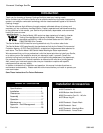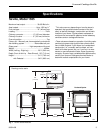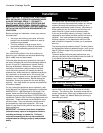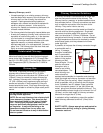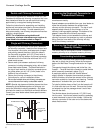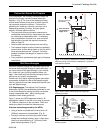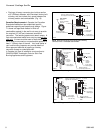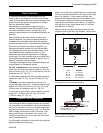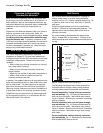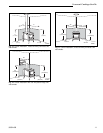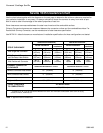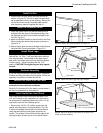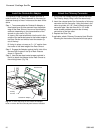
9
Vermont Castings Seville
30001490
Floor Protection
A tremendous amount of heat radiates from the
bottom plate of your Madison. The floor area directly
under and around the stove will require protection from
radiant heat as well as from stray sparks or embers
that may escape the firebox.
Heat protection is provided through the use of a
Vermont Castings Bottom Heat Shield #1889. Spark
and ember protection must be provided by a floor
protector constructed with noncombustible material as
specified.
Most installations will require that the bottom heat
shield be attached. Only when the stove is placed on a
completely noncombustible surface such as unpainted
concrete over earth may it be used without the heat shield.
Even when the bottom heat shield is installed, you
must provide special protection to the floor beneath.
For installations with the heat shield attached, use a
noncombustible floor protector such as 1/4” non-
asbestos mineral board or equivalent, or 24 gauge
sheet metal. The floor protector may be covered with a
noncombustible decorative material if desired. Do not
obstruct the space under the heater.
Protection requirements vary somewhat between the
United States and Canada as follows:
For U.S. installations the floor protector is required
under the stove and must extend at least 16” from the
front of the stove (“B”, Fig. 12), and at least 6” from the
sides and rear (“A”, Fig. 12).
To meet these requirements, a floor protector must be
at least 36” wide (“C”,Fig. 12) and 50” deep (“D”,Fig.
12)
In Canada, a noncombustible floor protector is re-
quired under the heater also. The floor protector must
extend 18” (457mm) to the front (“B”, Fig. 12), and 8”
(203mm) from the sides and rear (“A”, Fig. 12).
To meet these requirements, a floor protector must be
at least 40” (1016mm) wide (“C”,Fig. 12) and 54”
(1372mm) deep (“D”, Fig. 12).
Fireplace Hearth Protection
Do not assume that your fireplace hearth is completely
noncombustible. Many fireplace hearths do not satisfy
the “completely noncombustible” requirement because
the brick or concrete in front of the fireplace opening is
supported by heavy wood framing. (Fig. 13) Because
heat is readily conducted by brick or concrete, it can
easily pass through to the wood. As a result, such
fireplace hearths can be a fire hazard and are consid-
ered a combustible floor.
For all fireplace installations, follow the floor protection
guidelines described previously.
Keep in mind that many raised hearths will extend less
than the required clearance from the front of the heater
when it is installed. In such cases, sufficient floor
protection as described above must be added in front
of the hearth to satisfy the minimum floor protector
requirement from the front of the stove: 16" (406mm)
from the front in the United States and 18" (457mm)
from the front in Canada.
Hearth rugs do not satisfy the requirements for floor
protection as they are only fire-retardant, not fire proof.
Fig. 13 Supporting timbers under fireplace hearths are
considered to be combustible.
Wood framing
requires protection
from radiant heat
ST247
Fig. 12 These dimensions are minimum requirements only.
Use greater dimensions whenever possible.
Floor Protection Requirements
A:6"8"(203mm)
B: 16" 18” (457mm)
C: 36” 40” (1016mm)
D: 50” 54” (1372mm)
U. S. Canada
A
A
A
D
C
B
ST482




